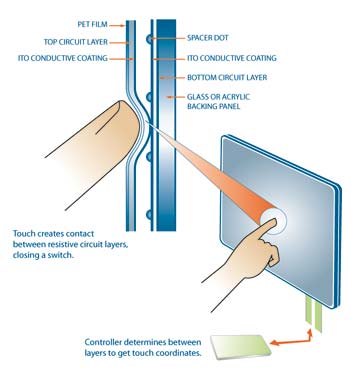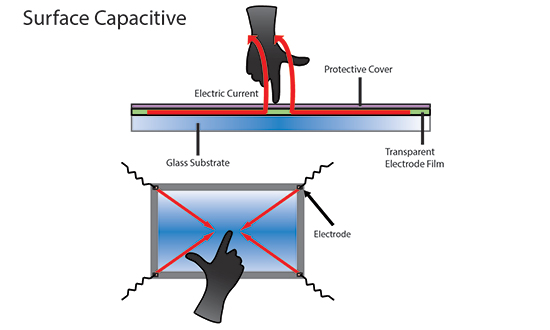TECHNOLOGY BEHIND TOUCHSCREENS
Hello, Friends Today I am with a topic which fascinates every one The touch screen applications sound fascinating right? yeah although we are living in the generation of the screen age
Let's get into this topic without any delay
If we go back to the past we find the real genius who invented this fascinated and frisky technology it's Jhonson who invented the first touch screen
Although it could analyze only a single touch response which led to the invention of the fully functional touch screen in the late 1980s
MAGIC BEHIND THE TOUCH SCREENS: it's WORKING
There are more than 6 types of touch screens but today we are going to focus on the two most popular touch screen technologies
1.Resistive touch screens
2.Capacitive touch screens
How does the resistive touchscreen respond?
Just press on the screen hard enough so that the screen bends and resists our touch resulting in the output we desire
Getting into technical terms resistive screens are made by two layers in which one layer is resistive and the other is conductive and both layers are separated by a medium called spaces
Here as we apply pressure on the screen the resistive layer analyses the touch input and as the screen is bent the two layers are squeezed and the difference in the current is analyzed by the software resulting in the output


Resistive touch screens find use in ATMs, industries and in many medical equipments
Here comes the most awaited part of this technology Capacitive touch screen which finds use nearly in all consumer-related products like the most loved smartphones tablets and many more
Here comes its working
Capacitive touch screen changes electric current when it comes
into contact with anything that conducts electric charge
These capacitive touch screens are made by indium tin oxide or copper oxide both of these materials keep electrical charges in super tiny wires, with each of them being thinner than our hair
We have two types of capacitive touch screens
1.Projective
2.Surface
Projective:

and surface capacitive touch screen:


Whichever type of capacitive screen you use, as soon as your finger hits the display, it transfers tiny electric chargeback to your finger Hence we have a complete circuit which leads to a potential drop in a particular place on a screen and here the software comes into play as it analyses the location of potential drop and follows our command
Let's continue with more fascinating technologies on my next blog
Heres my question to all the readers
Why we can't use a smartphone when the screen is wet comment down your answers and feel free to raise quires related to this topic
Let's get into this topic without any delay
If we go back to the past we find the real genius who invented this fascinated and frisky technology it's Jhonson who invented the first touch screen
Although it could analyze only a single touch response which led to the invention of the fully functional touch screen in the late 1980s
MAGIC BEHIND THE TOUCH SCREENS: it's WORKING
There are more than 6 types of touch screens but today we are going to focus on the two most popular touch screen technologies
1.Resistive touch screens
2.Capacitive touch screens
How does the resistive touchscreen respond?
Just press on the screen hard enough so that the screen bends and resists our touch resulting in the output we desire
Getting into technical terms resistive screens are made by two layers in which one layer is resistive and the other is conductive and both layers are separated by a medium called spaces
Here as we apply pressure on the screen the resistive layer analyses the touch input and as the screen is bent the two layers are squeezed and the difference in the current is analyzed by the software resulting in the output


Resistive touch screens find use in ATMs, industries and in many medical equipments
Here comes the most awaited part of this technology Capacitive touch screen which finds use nearly in all consumer-related products like the most loved smartphones tablets and many more
Here comes its working
Capacitive touch screen changes electric current when it comes
into contact with anything that conducts electric charge
These capacitive touch screens are made by indium tin oxide or copper oxide both of these materials keep electrical charges in super tiny wires, with each of them being thinner than our hair
We have two types of capacitive touch screens
1.Projective
2.Surface
Projective:

and surface capacitive touch screen:


Whichever type of capacitive screen you use, as soon as your finger hits the display, it transfers tiny electric chargeback to your finger Hence we have a complete circuit which leads to a potential drop in a particular place on a screen and here the software comes into play as it analyses the location of potential drop and follows our command
Let's continue with more fascinating technologies on my next blog
Heres my question to all the readers
Why we can't use a smartphone when the screen is wet comment down your answers and feel free to raise quires related to this topic

It's simply wonderful and amazing
ReplyDeleteThe admin is doing a great job...carry on with more blogs like this..these r very informative...
ReplyDelete